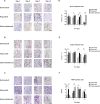Effect of autophagy on aging-related changes in orthodontic tooth movement in rats
- PMID: 38997686
- PMCID: PMC11245873
- DOI: 10.1186/s12903-024-04549-3
Effect of autophagy on aging-related changes in orthodontic tooth movement in rats
Abstract
Background: The number of adult orthodontic patients is increasing, and studies have shown that autophagy is involved in regulating orthodontic tooth movement and plays an important role in aging-related changes. Therefore, we aimed to explore the role of autophagy in aging-related changes during orthodontic tooth movement by establishing a rat orthodontic tooth movement model.
Methods: Forty-five 6-week-old and sixty-five 8-month-old male Sprague-Dawley rats were selected to represent adolescents and adults and establish orthodontic tooth movement model. They were sacrificed on days 0,1,3,7 and 14. Immunohistochemistry, immunofluorescence and tartrate resistant acid phosphatase (TRAP) staining were applied to measure the expression level of osteogenesis, autophagy, aging factors and osteoclast number in periodontal membrane of left upper first molar during orthodontic tooth movement. Then, we regulated the autophagy level by injecting autophagy activator rapamycin during orthodontic tooth movement and measured these factors and tooth movement distance by micro-computed tomography.
Results: Aging factor levels in the periodontal membrane were higher in adult rats than in adolescent rats and the autophagy factor levels were lower. The levels of osteogenic factors were lower on the tension side in adult rats than in adolescent rats. The peak osteoclast number on the pressure side occurred later in adult rats than in adolescent rats. The injection of rapamycin increased autophagy, accelerated orthodontic tooth movement in adult rats, and reduced the levels of aging factors. The levels of osteogenic factors were higher and reached those in adolescent rats at some time points. The number of osteoclasts increased significantly in the early stage.
Conclusions: Autophagy may play a substantial role in regulating aging-related changes in orthodontic tooth movement.
Keywords: Aging; Autophagy; Bone remodeling; Tooth movement.
© 2024. The Author(s).
Conflict of interest statement
The authors declare no competing interests.
Figures








Similar articles
-
Effect of anti-sclerostin antibody on orthodontic tooth movement in ovariectomized rats.Prog Orthod. 2024 Nov 25;25(1):45. doi: 10.1186/s40510-024-00544-0. Prog Orthod. 2024. PMID: 39581932 Free PMC article.
-
PTH/PTHrP in controlled release hydrogel enhances orthodontic tooth movement by regulating periodontal bone remodaling.J Periodontal Res. 2021 Oct;56(5):885-896. doi: 10.1111/jre.12885. Epub 2021 Apr 15. J Periodontal Res. 2021. PMID: 33856055
-
[Effect of local injection of rhTGF-α1 on osteoclasts during orthodontic tooth movement in rats].Shanghai Kou Qiang Yi Xue. 2014 Aug;23(4):423-6. Shanghai Kou Qiang Yi Xue. 2014. PMID: 25338791 Chinese.
-
Mkx regulates the orthodontic tooth movement via osteoclast induction.J Bone Miner Metab. 2021 Sep;39(5):780-786. doi: 10.1007/s00774-021-01233-2. Epub 2021 May 14. J Bone Miner Metab. 2021. PMID: 33988755
-
The age-related effects on orthodontic tooth movement and the surrounding periodontal environment.Front Physiol. 2024 Sep 6;15:1460168. doi: 10.3389/fphys.2024.1460168. eCollection 2024. Front Physiol. 2024. PMID: 39308977 Free PMC article. Review.
Cited by
-
Serum Starvation Regulates Autophagy of Human Periodontal Ligament Cells Through Reactive Oxygen Species Mediated Adenosine Monophosphate-Activated Protein Kinase/Mechanistic Target of RAPAMYCIN Axis.Int Dent J. 2025 Jun;75(3):1461-1471. doi: 10.1016/j.identj.2025.02.012. Epub 2025 Mar 21. Int Dent J. 2025. PMID: 40120460 Free PMC article.
-
Autophagy in orthodontic tooth movement: advances, challenges, and future perspectives.Mol Med. 2025 Jun 21;31(1):245. doi: 10.1186/s10020-025-01299-y. Mol Med. 2025. PMID: 40544242 Free PMC article. Review.
-
Effect of Simvastatin Combined with Photobiomodulation Therapy on Orthodontic Tooth Movement and the Expression of Metalloproteinases and Inhibitors - An Experimental Study.Lasers Med Sci. 2025 Apr 14;40(1):191. doi: 10.1007/s10103-025-04443-6. Lasers Med Sci. 2025. PMID: 40229562
References
-
- Kou Y, Li C, Yang P, The W9 peptide inhibits osteoclastogenesis and osteoclast activity by downregulating osteoclast autophagy and promoting osteoclast apoptosis. J Mol Histol., Luther L et al. F. Adults seeking orthodontic treatment: expectations, periodontal and TMD issues. Br Dent J. 2015;218(3):111–117. - PubMed
-
- L., Christensen F., Luther (2015) Adults seeking orthodontic treatment: expectations periodontal and TMD issues British Dental Journal 218(3) 111-117 10.1038/sj.bdj.2015.46 - PubMed
MeSH terms
Substances
Grants and funding
LinkOut - more resources
Full Text Sources
Medical

